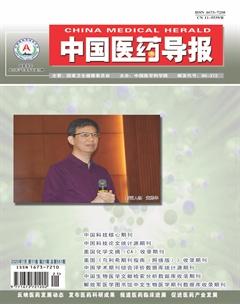2012—2018年揚州市婦幼保健院產后靜脈血栓的分析
任衛娟 張靜 馮永 黃靖冰 肖敏 張慧妍



[摘要] 目的 探討產后靜脈血栓的發生率、危險因素、發生時間、臨床表現及診斷,避免過渡治療。 方法 對2012年1月—2018年12月揚州大學附屬醫院揚州市婦幼保健院(以下簡稱“我院”)收治47 948名孕產婦中5例產后發生靜脈血栓者的臨床資料進行回顧性分析。按2015年4月英國皇家婦產科醫師學會發布了關于降低妊娠期及產褥期靜脈血栓栓塞疾病發生風險的診療指南中標準進行評分,并且比較患者分娩前、血栓發現時凝血功能的差異。同時與我院2018年晚期妊娠無并發癥及合并癥的正常孕婦6525名的分娩前凝血功能進行比較。 結果 5例患者均經綜合性醫院及我院彩色多普勒超聲或CT肺動脈造影確診,深靜脈血栓3例,淺靜脈血栓2例,深靜脈血栓中1例肺栓塞。近6年發生率為(1.04~1.07)/萬。5例患者均發生在產后1周內,5例患者中1例危險因素評分為4分,1例患者危險因素評分為3分,3例患者危險因素評分為1分。有下肢疼痛癥狀患者4例。5例患者分娩前、血栓發現時凝血功能比較,差異無統計學意義(P > 0.05),但與6525名正常孕婦的分娩前凝血功能比較,5例患者分娩前凝血酶原時間、凝血酶時間短于正常孕婦(P < 0.05),活化部分凝血酶原時間、國際標準化比值、纖維蛋白原、D-二聚體比較,差異無統計學意義(P > 0.05)。經抗凝治療,5例患者均痊愈。 結論 產后靜脈血栓發病率低,分娩前PT、TT明顯縮短及分娩后出現下肢疼痛癥狀,警惕靜脈血栓的發生,一旦發生及早治療。
[關鍵詞] 靜脈血栓癥;淺靜脈栓塞;深靜脈血栓;肺栓塞;產后
[中圖分類號] R473.71? ? ? ? ? [文獻標識碼] A? ? ? ? ? [文章編號] 1673-7210(2020)07(c)-0121-04
Analysis of postpartum venous thrombosis in Yangzhou Maternal and Child Gare Service Centre from 2012 to 2018
REN Weijuan1*? ?ZHANG Jing2*? ?FENG Yong3? ?HUANG Jingbing2? ?XIAO Min2? ?ZHANG Huiyan1
1.Department of Obstetrics and Gynecology, Wuxi Rich Women and Children′s Hospital, Jiangsu Province, Wuxi? ?214002, China; 2.Department of Obstetrics and Gynecology, Yangzhou Maternal and Child Care Service Centre, Affilated Hospital of Yangzhou University, Jiangsu Province, Yangzhou? ?225002, China; 3.Information Section, Yangzhou Maternal and Child Care Service Centre, Affilated Hospital of Yangzhou University, Jiangsu Province, Yangzhou? ?225002, China
[Abstract] Objective To investigate the incidence, risk factors, occurrence time, clinical manifestations and diagnosis of postpartum venous thrombosis, and to avoid overtreatment. Methods The clinical data of five cases of postpartum venous thrombosis in 47 948 pregnant women admitted to Yangzhou Maternal and Child Care Service Centre (hereinafter referred to as “our hospital”) from January 2012 to December 2018 were retrospectively analyzed. The score according to the criteria set out in the April 2015 Royal College of Obstetricians and Gynaecologists guidelines on reducing the risk of venous thromboembolism during pregnancy and puerperium, the differences in clotting function before delivery and at the time of thrombus discovery were compared. Meanwhile, the coagulation function was compared with that of 6525 normal pregnant women without complications and complications in the third trimester pregnancy in our hospital in 2018. Results All five cases were confirmed by color doppler ultrasonography or CT pulmonary angiography in general hospitals and our hospital, including three cases of deep vein thrombosis, two cases of superficial vein thrombosis, and one case of deep vein thrombosis. In recent six years, the incidence was (1.04-1.07)/10 000. All of the five cases occurred within one week after delivery. Among the five patients, one case had a risk factor score of four, one case had a risk factor score of three, and three cases had a risk factor score of one. Four cases had lower extremity pain symptoms. Comparison of coagulation function between the five patients before delivery and at the time of thrombosis discovery showed no statistically significant difference (P > 0.05). However, compared with the coagulation function before delivery of 6525 normal pregnant women, the prothrombin time (PT) and thrombin time (TT) of five cases before delivery were shorter than that of normal pregnant women (P < 0.05). There were no significant differences in activated partial prothrombin time, international standardized ratio, fibrinogen and D-dimer (P > 0.05). After anticoagulant therapy, all the five cases recovered. Conclusion The incidence of postpartum venous thrombosis is low, PT and TT before delivery are shortened significantly and lower limb pain symptoms appear after delivery.
低分子肝素、肝素是產后的首選抗凝治療,必要時可加用華法林,產后華法林對母乳喂養是安全的[2,20]。至于抗凝持續時間目前指南推薦至少到產后6周,停抗凝藥物前,應由血管外科醫師進行評估,以決定是否需要進一步治療[21]。
綜上所述,產后靜脈血栓發病率低,但發生都有一定危險因素,目前尚不能提供良好的篩查指標。產婦出現下肢疼痛癥狀以及分娩前PT、TT明顯縮短,產后形成靜脈血栓明顯增高。彩色多普勒超聲是最簡便的診斷方法,低分子肝素、肝素是產后的首選抗凝治療。避免過渡治療會造成患者經濟負擔及出血風險,國內需要進行流行病學數據分析,制訂出診療指南或共識。
[參考文獻]
[1]? 朱燕,陳奕.妊娠相關血栓栓塞性疾病的風險評估及預防研究現狀[J].中華醫學雜志,2018,98(23):1893-1896.
[2]? 劉真,孫瑜.妊娠期及產褥期靜脈血栓栓塞疾病診治:2015英國皇家婦產科醫師學會指南解讀[J].中華圍產醫學雜志,2017,20(12):841-845.
[3]? Royal College of Obstetricians and Gynaecologists. Thromboembolic Disease in Pregnancy and the Puerperium:Acute Management. Green-top Guideline No.37a[S/OL].(2015-04-30)[2017-07-15]. https://www. rcog. org.uk/globalassets/ documents/guidelines/gtg-37b.pdf.
[4]? 王晨,楊慧霞.2018年美國婦產科醫師學會關于“妊娠期血栓栓塞癥”的新推薦[J].中華圍產醫學雜志,2019, 22(2):139-140.
[5]? Abdul SA,Tata LJ,Grainge MJ,et al. The incidence of first venous thromboembolism in and around pregnancy using linked primary and secondary care data:a population based cohort study from England and comparative meta-analysis [J]. PLoS One,2013,8(7):e70310.
[6]? Jacobsen AF,Skjeldestad FE,Sandset PM. Incidence and risk patterns of venous thromboembolism in pregnancy and puerperium--a register-based case-control study [J]. Am J Obstet Gynecol,2008,198(2):233.e1-e7.
[7]? Liew NC,Alemany GV,Angchaisuksiri P,et al. Asian venous thromboembolism guidelines:updated Recommendations for the prevention of venous thromboembolism [J]. Int Angiol,2017,36(1):1-20.
[8]? Chan LY,Tam WH,Lau TK. Venous thromboembolism in pregnancy Chinese women [J]. Obstet Gynecol,2001,98(3):471-475.
[9]? Abdul SA,Grainge MJ,West J,et al. Impact of risk factors on the timing of first postpartum venous thromboembolism:a population-based cohort study from England [J]. Blood,2014,124(18):2872-2880.
[10]? Middeldorp S. Thrombosis in women:what are the knowledge gaps in 2013 [J]. J Thromb Haemost,2013,11(Suppl 1):180-191.
[11]? Royal College of Obstetricians and Gynaecologists. Reducing the risk of thrombosis and embolism during pregnancy and the puerperium. Green-Top Guideline No .37a [EB/OL]. London:RCOG.(2015-04-30)[2018-05-20]. https://www.rcog.org.uk/globalassets/documents/guidelines/gtg-37a.pdf.
[12]? D′Alton ME ,Friedman AM,Smiley RM,et al. National partnership for maternal safety:consensus bundle on venous thromboembolism [J]. Obstet Gynecol,2016,128(4):688-698.
[13]? 方婧,戴毅敏,顧寧,等.通過41例產科靜脈血栓評價不同指南的推薦差異[J].中國婦幼健康研究,2019,30(8):941-945.
[14]? Caprini JA. Risk assessment as a guide to thrombosis prophylaxis [J]. Curr Opin Pulm Med,2010,16(5):448-452.
[15]? 趙芳,劉佳宜,潘曉玉.妊娠相關性靜脈血管栓塞性疾病6例分析及文獻復習[J].中日友好醫院學報,2018, 32(5):259-262,266.
[16]? 陳奕,朱燕.妊娠期及產褥期靜脈血栓栓塞癥的診斷與治療[J].中華婦產科雜志,2018,53(9):635-639.
[17]? 邵素臣,俞昌明.彩色多普勒超聲在下肢深靜脈血栓診斷中的臨床應用[J].醫學影像學雜志,2017,27(4):783-786.
[18]? 徐建云,周夢林,何玉花,等.高齡產婦分娩前后D-二聚體水平變化特點及其臨床意義[J].中華醫學雜志,2019,99(35):2768-2772.
[19]? 李帥,呂時銘,湯杰英.浙江地區漢族孕產婦D-二聚體參考區間的建立及應用[J].中華檢驗醫學雜志,2011,4(7):580-585.
[20]? 韋永剛,付德安.低分子肝素聯合華法林治療次大面積肺栓塞患者的臨床觀察[J].中國醫學創新,2018,15(20):54-58.
[21]? 趙鵬,藺莉,欒景源,等.妊娠及產褥期靜脈血栓栓塞的危險因素評估及處理策略[J].中華圍產醫學雜志,2019, 22(6):429-431.
(收稿日期:2019-10-29)

